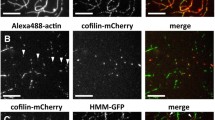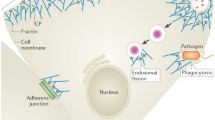Abstract
Actin binding proteins control actin assembly and disassembly by altering the critical concentration and by changing the kinetics of polymerization. All of these control mechanisms in some way or the other make use of the energy of hydrolysis of actin-bound ATP. Capping of barbed filament ends increases the critical concentration as long as ATP hydrolysis maintains a difference in the actin monomer binding constants of the two ends. A further increase in the critical concentration on adding a second cap, tropomodulin, to the other, pointed filament end also requires ATP hydrolysis as described by the model presented here. Changes in the critical concentration are amplified into much larger changes of the monomer pool by actin sequestering proteins, provided their actin binding equilibrium constants fall within a relatively narrow range around the values for the two critical concentrations of actin. Cofilin greatly speeds up treadmilling, which requires ATP hydroysis, by increasing the rate constant of depolymerization. Profilin increases the rate of elongation at the barbed filament end, coupled to a lowering of the critical concentration, only if ATP hydrolysis makes profilin binding to the barbed end independent of its binding constant for actin monomers.
Similar content being viewed by others
References
Oosawa F, Asakura S: Thermodynamics of the polymerization of proteins, Academic Press New York, 1975
Carlier M-F: Actin: Protein structure and filament dynamics. J Biol Chem 266: 1–4, 1991
Pollard TD, Cooper JA: Actin and actin binding proteins. A critical evaluation of mechanisms and functions. Ann Rev Biochem 55: 987–103, 1986
Wegner A: Treadmilling of actin at physiological salt solutions. J Mol Biol 161: 607–615, 1982
Young CL, Southwick FS, Weber A: Kinetics of the interaction of a 41-kilodalton macrophage capping protein with actin: Promotion of nucleation during prolongation of the lag period. Biochemistry 29: 2232–2240, 1990
Schafer DA, Cooper JA: Control of actin assembly at filament ends. Ann Rev Cell Dev Biol 11: 497–514, 1995
Weber A, Pennise CR, Babcock Gary G, Fowler VM: Tropomodulin caps the pointed ends of actin filaments. J Cell Biol 127: 1627–1635, 1994
Fowler VM: Identification and purification of a novel Mr 43,000 tropomyosin binding protein from human erythrocyte membranes. J Biol Chem 262: 12792–12800, 1987
Fowler VM: Regulation of actin filament length in erythrocytes and muscle. Curr Opin Cell Biol 8: 86–96, 1996
Detmers P, Weber A, Elzinga M, Stephens RE: 7-chloro-4-nitrobenzeno-2-oxa-1,3-diazole actin as a probe for actin polymerization. J Biol Chem 256: 99–105, 1981
Weber A, Nachmias VT, Pennise CR, Pring M, Safer D: Interaction of thymosin β4 with muscle and platelet actin: implications for actin sequestration in resting platelets. Biochemistry 31: 6179–6185, 1992
Goldschmidt-Clemont PJ, Machesky LM, Baldassare JJ, Pollard TD: The actin-binding protein profilin binds to PIP2 and inhibits its hydrolysis by phospholipase C. Science 247: 1575–1578, 1990
Sun HQ, Kwiatkowska K, Yin HL: Actin monomer binding proteins. Curr Opin Cell Biol 7: 102–110, 1995
Moon AL, Janmey PA, Louie KA, Drubin DG: Cofilin is an essential component of the yeast cortical cytoskeleton. J Cell Biol 120: 421–435, 1993
Carlier M-F, Laurent V, Santolini J, Melki R, Didry D, Xia G-X, Hong Y, Chua WK, Pantaloni D: Actin depolymerizing factor (ADF/cofilin) enhances the rate of filament turnover: Implication for actin-based motility. J Cell Biol 136: 1307–1322, 1997
Theriot JA, Mitchison TJ: Actin microfilament dynamics in locomoting cells. Nature 352: 126–131, 1991
Zigmond SH: Recent quantitative studies of actin filament turnover during cell locomotion. Cell Motil Cytoskeleton 25: 309–316, 1993
Pollard TD: Actin cytoskeleton. Missing link for intracellular bacterial motility. Curr Biol 5: 837–840, 1995
Rosenblatt J, Agnew BJ, Abe H, Bamburg JR, Mitchison TJ: Xenopos actin depolymerizing factor/cofilin (XAC) is responsible for the turnover of actin filaments in Listeria monocytogenes tails. J Cell Biol 136: 1323–1332, 1997
Agnew BJ, Minamide LS, Bamburg JR: Reactivation of phosphorylated actin depolymerizing factor and identification of the regulatory site. J Biol Chem 270: 17582–17587, 1995
Aizawa H, Sutoh K, Yahara I: Overexpression of cofilin stimulates bundling of actin filaments, membrane ruffling, and cell movement in Dictyostelium. J Cell Biol 132: 335–344, 1996
Sohn RH, Goldschmidt-Clemont PJ: At the crossroads of signal transduction and the actin cytoskeleton. Bioassays 16: 465–472, 1994
Pantaloni D, Carlier MF: How profilin promotes actin filament assembly in the presence of thymosin-β4. Cell 75: 1007–1014, 1993
Pring M, Weber A, Bubb MR: Profilin-actin complexes directly elongate actin filaments at the barbed end. Biochemistry 31: 1827–1836, 1992
Tilney LC, Inoue S: Acrosomal reaction of Thione sperm III. The relationship between actin assembly and water influx during extension of the acrosomal process. J Cell Biol 100: 1273–1283, 1985
Tilney LC, Inoue S: Acrosomal reaction of Thione sperm II. The kinetics and possible mechanism of acrosomal process elongation. J Cell Biol 91: 820–827, 1982
Tilney LC, Bonder EM, Coluccio LM, Mooseker MS: Actin from Thyone sperm assembles on only one end of an actin filament: A behaviour regulated by profilin. J Cell Biol 97: 112–124, 1983
Pollard TD, Cooper JA: Quantitative analysis of the effect of Acanthamoeba profilin on actin filament nucleation and elongation. Biochemistry 23: 6631–6641, 1984
Kaiser DA, Sato M, Ebert RF, Pollard TD: Purification and characterization of two isoforms of acantharroeba profilin. J Cell Biol 102: 221–226, 1986
Cooley L, Verheyen E, Ayers K: Chicadee encodes a profilin required for intercellular cytoplasm transport during Drosophila oogenesis. Cell: 69: 173–184, 1992
Haarer BK, Lillie SH, Adams AEM, Magdolen V, Bandlow W, Brown SS: Purification of profilin from Saccharomyces cerevisiae and analysis of profilin-deficient cells. J Cell Biol 110: 105–114, 1989
Author information
Authors and Affiliations
Rights and permissions
About this article
Cite this article
Weber, A. Actin binding proteins that change extent and rate of actin monomer-polymer distribution by different mechanisms. Mol Cell Biochem 190, 67–74 (1999). https://doi.org/10.1023/A:1006984010267
Issue Date:
DOI: https://doi.org/10.1023/A:1006984010267
- actin
- actin depolymerizing factor
- actin monomer pool
- actin monomoer sequestration
- ATP hydrolosis
- capping proteins
- cofilin
- critical concentration changes
- coordinated calcium regulation
- depolymerization rate constant
- elongation rates
- Ebashi
- lamellipodia
- Listeria monocytogenes
- leucocytes
- myosin heads
- platelets
- profilin
- thymosin-β4
- Thyone acrosome
- treadmilling
- troponin
- tropomodulin




